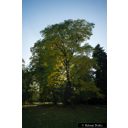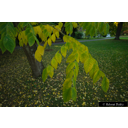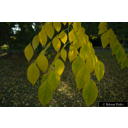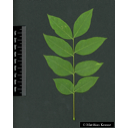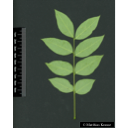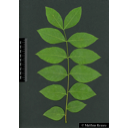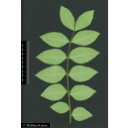Useful information about the taxon (species, subspecies, variety...)
Gymnocladus dioica (L.) K. Koch
Fabaceae (Leguminosae, Papilionaceae)
(APG IV)Kentucky coffeetree, chicot tree, dead tree, stump tree
Taxon concept: The Plant List (2010)
Distribution: Eastern and Central North America: Canada: Ontario; USA: northeastern, north-central, northern and southern States of the Great Plains, southeastern
Gymnocladus dioicus (L.) K. Koch - Accepted: Gymnocladus dioicus (L.) K. Koch bei Zander 2008; Familie: Caesalpiniaceae (Zander 2008)Gymnocladus dioicus (L.) K. Koch - : bei Zander 2008; Familie: Caesalpiniaceae (Zander 2008)Gymnocladus dioicus (L.) K. Koch - Synonym: Gymnocladus dioica (L.) K. Koch bei The Plant List (2010); Familie: Fabaceae (Leguminosae, Papilionaceae) (APG III)Gymnocladus dioica (L.) K. Koch - Accepted: Gymnocladus dioica (L.) K. Koch bei The Plant List (2010); Familie: Fabaceae (Leguminosae, Papilionaceae) (APG III)Gymnocladus dioica (L.) K. Koch - Accepted: Gymnocladus dioica (L.) K. Koch bei The Plant List (2014), version 1.1; Familie: Fabaceae (Leguminosae, Papilionaceae) (APG III)Gymnocladus dioica (L.) K. Koch - Accepted: Gymnocladus dioica (L.) K. Koch bei The Plant List (2014), version 1.1; Familie: Fabaceae (Leguminosae, Papilionaceae) (APG IV)
- Flowers
- dioecious or polygamodioecious flowers
- Flower ecology
- animal-pollinated (bumblebees, digger bees, butterflies, hummingbirds)
- Life form
- tree
- Foliage persistence
- deciduous
- Fruits
- fruit is a thick, woody legume, filled with a sweet gelatinous substance; fruit usually persists indehiscent on the tree during winter
- Fruit ecology
- water-dispersed (hydrochorous) (in prehistorical times presumably zoochorous by the now-extinct American mastodons or other mammals)
- Soil conditions
- preferentially on sunny, moist, humus-rich, limestone soils
- Natural occurrence (habitat)
- deciduous woodlands, bottomland woodlands, riverbanks; rocky, open wooded hillsides
- Vegetation typ and synecology (plant community)
- temperate, mixed mesophytic deciduous forests
- Constraints according habitat
- tolerates drought, occasional flooding and urban pollution
- Usage
- as ornamental tree, in landscape plantings and parks; wood is used for cabinet works, furniture, fencing and railway sleepers; fruit is used as a soap due to high content of saponins; the roasted seeds were used as a coffee substitute
Hedrick. U. P. (1972): Sturtevant's Edible Plants of the World. Taschenbuch. Dover Publications Inc., Mineola, New York: 686 S. ISBN 0-486-20459-6.; The International Plant Names Index (2009). Published on the Internet http://www.ipni.org; Courtesy to IPNI, 2009. Exported from IPNI at date: 2009-09-22 20:17:51; Van den Berk Nurseries (Accessed 2018): Tilia mongolica. See: https://www.vdberk.co.uk/trees/tilia-mongolica/;
Diese Webseite verwendet Google Maps, um Karten und Standorte von Pflanzen in den Hohenheimer Gärten anzuzeigen. Dadurch werden unter Umständen Daten an Google weitergeleitet, was mit einer Verarbeitung Ihrer personenbezogenen Daten verbunden sein kann. Die Datenschutzerklärung von Google finden Sie hier: Datenschutzerklärung von Google
| Sex | Standort | Accession number | Planting year | Donation | IPEN | Lat. | Long. |
|---|---|---|---|---|---|---|---|
| Parzelle I | EG-I-042-17851 | 1981 | XX-0-HOH-EG-I-042-17851 | 48,7087036281 | 9,2079745582 | ||
| Parzelle M | EG-M-060-17852 | 1962 | XX-0-HOH-EG-M-060-17852 | 48,7085867691 | 9,2084929666 | ||
| Parzelle X | LG-X-202-17853 | 2003 | XX-0-HOH-LG-X-202-17853 | 48,7055688812 | 9,2141414191 | ||
| Parzelle G | SP-GB-017-2847 | 2017 | XX-0-HOH-SP-GB-017-2847 | 48,7107213826 | 9,2131058655 | ||
| female | Parzelle G | SP-GB-026-1761 | 2018 | XX-0-HOH-SP-GB-026-1761 | 48,7107912913 | 9,2133045182 | |
| Parzelle G | SP-GB-036-17850 | 2017 | XX-0-HOH-SP-GB-036-17850 | 48,7107984862 | 9,2137650054 |

